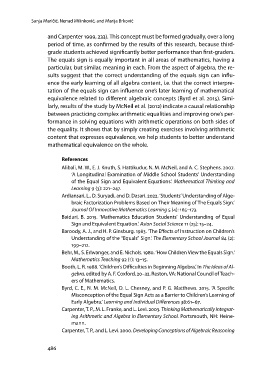Page 486 - Istenič Andreja, Gačnik Mateja, Horvat Barbara, Kukanja Gabrijelčič Mojca, Kiswarday Vanja Riccarda, Lebeničnik Maja, Mezgec Maja, Volk Marina. Ur. 2023. Vzgoja in izobraževanje med preteklostjo in prihodnostjo. Koper: Založba Univerze na Primorskem
P. 486
ja Maričić, Nenad Milinković, and Marija Brković
and Carpenter 1999, 233). This concept must be formed gradually, over a long
period of time, as confirmed by the results of this research, because third-
grade students achieved significantly better performance than first-graders.
The equals sign is equally important in all areas of mathematics, having a
particular, but similar, meaning in each. From the aspect of algebra, the re-
sults suggest that the correct understanding of the equals sign can influ-
ence the early learning of all algebra content, i.e. that the correct interpre-
tation of the equals sign can influence one’s later learning of mathematical
equivalence related to different algebraic concepts (Byrd et al. 2015). Simi-
larly, results of the study by McNeil et al. (2012) indicate a causal relationship
between practicing complex arithmetic equalities and improving one’s per-
formance in solving equations with arithmetic operations on both sides of
the equality. It shows that by simply creating exercises involving arithmetic
content that expresses equivalence, we help students to better understand
mathematical equivalence on the whole.
References
Alibali, M. W., E. J. Knuth, S. Hattikudur, N. M. McNeil, and A. C. Stephens. 2007.
‘A Longitudinal Examination of Middle School Students’ Understanding
of the Equal Sign and Equivalent Equations.’ Mathematical Thinking and
Learning 9 (3): 221–247.
Ardiansari, L., D. Suryadi, and D. Dasari. 2022. ‘Students’ Understanding of Alge-
braic Factorization Problems Based on Their Meaning of The Equals Sign.’
Journal Of Innovative Mathematics Learning 5 (4): 165–173.
Baiduri, B. 2015. ‘Mathematics Education Students’ Understanding of Equal
Sign and Equivalent Equation.’ Asian Social Science 11 (25): 15–24.
Baroody, A. J., and H. P. Ginsburg. 1983. ‘The Effects of Instruction on Children’s
Understanding of the “Equals” Sign.’ The Elementary School Journal 84 (2):
199–212.
Behr, M., S. Erlwanger, and E. Nichols. 1980. ‘How Children View the Equals Sign.’
Mathematics Teaching 92 (1): 13–15.
Booth, L. R. 1988. ‘Children’s Difficulties in Beginning Algebra.’ In The Ideas of Al-
gebra, edited by A. F. Coxford, 20–32. Reston, VA: National Council of Teach-
ers of Mathematics.
Byrd, C. E., N. M. McNeil, D. L. Chesney, and P. G. Matthews. 2015. ‘A Specific
Misconception of the Equal Sign Acts as a Barrier to Children’s Learning of
Early Algebra.’ Learning and Individual Differences 38:61–67.
Carpenter, T. P., M. L. Franke, and L. Levi. 2003. Thinking Mathematically Integrat-
ing Arithmetic and Algebra in Elementary School. Portsmouth, NH: Heine-
mann.
Carpenter, T. P., and L. Levi. 2000. Developing Conceptions of Algebraic Reasoning
486
and Carpenter 1999, 233). This concept must be formed gradually, over a long
period of time, as confirmed by the results of this research, because third-
grade students achieved significantly better performance than first-graders.
The equals sign is equally important in all areas of mathematics, having a
particular, but similar, meaning in each. From the aspect of algebra, the re-
sults suggest that the correct understanding of the equals sign can influ-
ence the early learning of all algebra content, i.e. that the correct interpre-
tation of the equals sign can influence one’s later learning of mathematical
equivalence related to different algebraic concepts (Byrd et al. 2015). Simi-
larly, results of the study by McNeil et al. (2012) indicate a causal relationship
between practicing complex arithmetic equalities and improving one’s per-
formance in solving equations with arithmetic operations on both sides of
the equality. It shows that by simply creating exercises involving arithmetic
content that expresses equivalence, we help students to better understand
mathematical equivalence on the whole.
References
Alibali, M. W., E. J. Knuth, S. Hattikudur, N. M. McNeil, and A. C. Stephens. 2007.
‘A Longitudinal Examination of Middle School Students’ Understanding
of the Equal Sign and Equivalent Equations.’ Mathematical Thinking and
Learning 9 (3): 221–247.
Ardiansari, L., D. Suryadi, and D. Dasari. 2022. ‘Students’ Understanding of Alge-
braic Factorization Problems Based on Their Meaning of The Equals Sign.’
Journal Of Innovative Mathematics Learning 5 (4): 165–173.
Baiduri, B. 2015. ‘Mathematics Education Students’ Understanding of Equal
Sign and Equivalent Equation.’ Asian Social Science 11 (25): 15–24.
Baroody, A. J., and H. P. Ginsburg. 1983. ‘The Effects of Instruction on Children’s
Understanding of the “Equals” Sign.’ The Elementary School Journal 84 (2):
199–212.
Behr, M., S. Erlwanger, and E. Nichols. 1980. ‘How Children View the Equals Sign.’
Mathematics Teaching 92 (1): 13–15.
Booth, L. R. 1988. ‘Children’s Difficulties in Beginning Algebra.’ In The Ideas of Al-
gebra, edited by A. F. Coxford, 20–32. Reston, VA: National Council of Teach-
ers of Mathematics.
Byrd, C. E., N. M. McNeil, D. L. Chesney, and P. G. Matthews. 2015. ‘A Specific
Misconception of the Equal Sign Acts as a Barrier to Children’s Learning of
Early Algebra.’ Learning and Individual Differences 38:61–67.
Carpenter, T. P., M. L. Franke, and L. Levi. 2003. Thinking Mathematically Integrat-
ing Arithmetic and Algebra in Elementary School. Portsmouth, NH: Heine-
mann.
Carpenter, T. P., and L. Levi. 2000. Developing Conceptions of Algebraic Reasoning
486


